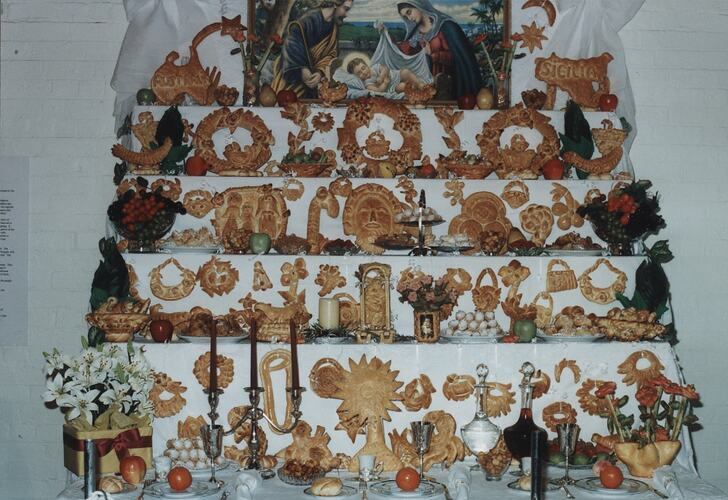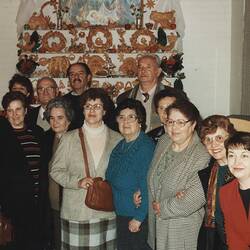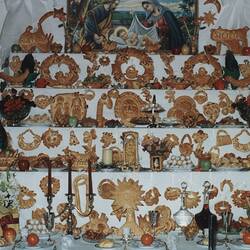Summary
A rich tradition of votive bread-making was brought to Australia by Italian migrants and practised in Victoria for decades.
Foundation of a Club:
The Valguarnera Italian Social Club was officially founded in 1969 following the first visit of an Italian President to Australia in 1967. Valguanera is a commune in the region of Sicily in Italy. President Giuseppe Saragat visited the major Australian cities pleading with Italian migrants not to forget their culture and language. In the wake of Mr Saragat's visit, numerous Italian clubs were established throughout Australia, and formal cultural exchanges were established, including Italian Government funding of Italian language classes.
After its formal establishment, the Valguanera Club members set out to organise functions so that its young people could meet with the intention to marry someone from their own cultural background, and as a way of reuniting the many who had settled but were dispersed across Melbourne's suburbs.
After years of fundraising, the club became a registered association in 1984, and was able to purchase a property in Heatherton Road, South Clayton, with the purpose of constructing club rooms where they could hold functions and events. A derelict brick building was upgraded for use as a members' function room. Many members with trades donated their time and expertise through brick and concrete-laying, tiling, plumbing, and landscaping. Functions and barbeques were held to raise money to pay for equipment and materials. Eventually a commercial kitchen and cold room were added enabling the club to cater for its own functions.
Tavola di San Giuseppe (St Joseph's Table) in Melbourne:
The Tavola di San Giuseppe (St Joseph's Table) was proposed in 1986 by one of the club's founders, Concetta Nasello, to celebrate one of the most revered saints in the Catholic religion. It is a popular and widely observed feast day across Italy generally, but particularly in Sicily. The idea was that the festa would showcase the traditional skills of the women of the Valguanera Club that would have been practised across Sicily but under threat in Australia as the women entered the paid workforce.
This annual festa became very popular amongst the Sicilian and wider community in and around Clayton and at its peak was attended by over 400 people, the capacity of the clubrooms.
The Tavola di San Giuseppe was one of the earliest functions to be held in the upgraded Valguanera club rooms. It replicated the celebration in Sicily, with the exception that a statue of the saint was not paraded from church, as is done in Sicily. A group of club members were selected to represent selected saints. They are seated at a multi-tiered table and partake in the traditional fare adorning the table.
Twelve club members, selected to represent the saints, including a young girl to represent the Virgin Mary, a very young boy to represent the child Jesus, and an elder widowed woman, who represented St Anne, Mary's mother. The celebration commenced with a quick procession by the designated saints parading through the club hall to take their place at predetermined seats at the base of the table. They were waited on by women called 'servi', whose role was to serve the saints, clear plates and refill glasses with drinks.
Before dining commenced, an Italian-speaking priest (usually asked to attend from a local church) recited the Lord's Prayer, said a few words and read a poem written especially for this festa by a devotee of the feast day from the town of Valguarnera. The priest also blessed the bounty on the table, and those role-playing the saints, as well as all the guests.
The 'saints' were then served dishes as part of the traditional ritual followed by table-serviced lunch for all guests attending the festa. At the conclusion of the lunch, the 'saints' were permitted to share what remained unconsumed on their table with their guests. At the end of the function, beautiful, highly decorative votive-shaped breads (the signature baked items produced for the festa) and various plates of traditional food adorning the tiers were auctioned to guests. The money raised was donated to a registered charity. Purchasing items from the table was considered to be good luck as they had all been blessed by a priest at the commencement of the function.
The Sicilian Festa Tradition:
The specifically Sicilian tradition of the Tavola di San Giuseppe is a centuries-old Christian celebration that is popular and widespread across Sicily, including the Aeolian Islands. The tradition celebrates the Holy Family with a procession of St Joseph, St Mary and Jesus uniting as a family in 'breaking bread', that is, having a meal. As San Giuseppe feast day at times falls around Easter, it was thought that the elaborate, mulit-tiered altar table, represented the feasting after the Lent fasting. The celebration is also linked to the abundance of produce available after harvest.
Some even believe that it commenced as a harvest festival before Christianity and then was appropriated as a Christian celebration to express gratitude for good fortune in plentiful harvests and provide an occasion for communities and families to share their good fortune with the less fortunate and poor.
The celebration also focused on food, fundamental to Italian culture. The preparation and sharing of meals are inextricably linked to Italian identity and tradition. The San Giuseppe table exemplifies this tradition by showcasing the importance of food in providing nurture, growth and strength for a family.
These 'dedications' to San Giuseppe, an important saint in Christianity, are usually undertaken by a town's wealthier citizens where tables were erected in their homes and neighbours invited to view the table and take prepared dishes. Priests are often invited (and paid) to bless the table.
Often neighbours come together to organise and contribute to street tables involving the entire street. The best hand-embroidered linens cover the table tiers and the best crockery and pictures of San Giuseppe and the Holy Family also adorn the table. Highly prized are the abundance of different votive breads cooked by the women of a particular family, a street, or a 'quartiere' (residential block).
As in many cultures, baking bread has been mostly women's domain. Making votive bread was a skill that was shared by many women. Sharing bread designs was a community affair where women learned from each other and from female elders.
However, making uniquely decorative bread was a creative process that only the most skilled women could undertake and sometimes certain designs were left to be made by their creators. There were two types of votive breads baked. The highly decorative bread mostly symbolising religious motifs was specifically prepared with additional salt which preserved the dough, allowing the baked bread to remain on the tables for days without deteriorating. A second batch of dough was prepared for consumption at the table for the festa.
Disposing of Unconsumed Votive Bread:
Votive bread is baked with extra salt to prevent it deteriorating in the days before the preparation of the table, so it is usually inedible. In towns and villages of Sicily, this bread is usually disposed of by crumbing it as feed for chickens and pigs.
In Melbourne, with most of the Valguarnerese population living in urban areas, this is not possible. Often the bread is kept for a year or so, and if some pieces are especially meaningful or decorative, the bread is kept much longer. If the bread has been blessed by a priest, and used on the 'tavola', it cannot be disposed of as kitchen waste. The blessed bread is seen as a sacred item to be disposed of appropriately. Burying it in the garden so that it nurtures the earth, or crumbing it for animal feed, is seen as appropriate. This tradition is similar to the blessed palms and olive branches given to parishioners on Palm Sunday during Lent. These items are kept until the following year, burned and turned into ash for use by priests at mass on Ash Wednesday, or just burned and disposed of in one's garden.
More Information
-
Keywords
-
Authors
-
Article types


